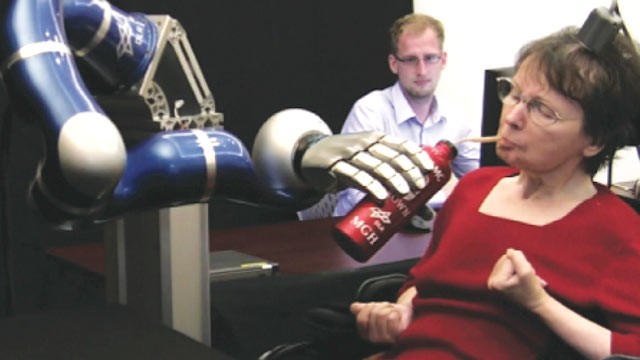Mind Control: How a Paralyzed Man Created Motion
Summary:
The article, "Paralyzed Man Uses Thoughts Alone to Control Robot Arm, Touch Friend's Hand, After Seven Years," describes how Tim Hemmes, a 30-year-old paralyzed man, was able to create motion and touch his friend's hand after seven years.Tim Hemmes was injured in a car accident, leaving him with a spinal cord injury that made him unable to move his body below the shoulders. The scientists conducted functional magnetic resonance imaging (fMRI) of Mr. Hemmes'
brain while he watched videos of arm movement. They used that
information to then put a postage stamp-size electrocortigraphy (ECoG) grid
of 28 recording electrodes on the brain region that fMRI
showed controlled right arm and hand movement. They connected wires that were placed under his skin to computer cables. The computer system, with the help brain-computer interface (BCI) technology, was able to detect Mr. Hemmes' brain activity and what he was thinking.
 Mr. Hemmes began testing the machine by watching a virtual arm move, which triggered neural signals that were sensed by the electrodes. He did that constantly for 12 days at his home and 9 days in the research lab. After practice, Tim was able to move a ball on the computer screen not only in 2D but also in 3D. When he mastered the computer, the scientists advanced Mr. Hemmes to the next level: the robotic arm. With the help of the scientists and the persistence of Tim himself, he was able to high-five people with the robotic arm, using 100% brain control.
Mr. Hemmes began testing the machine by watching a virtual arm move, which triggered neural signals that were sensed by the electrodes. He did that constantly for 12 days at his home and 9 days in the research lab. After practice, Tim was able to move a ball on the computer screen not only in 2D but also in 3D. When he mastered the computer, the scientists advanced Mr. Hemmes to the next level: the robotic arm. With the help of the scientists and the persistence of Tim himself, he was able to high-five people with the robotic arm, using 100% brain control.

NOS Themes:
Science is collaborative- Paralyzed man Tim Hemmes and the scientists worked together to create the perfect computer system to allow people who cannot move to achieve greater independence.
Importance of repetition- Mr. Hemmes spent 12 days at his home and 9 days in the research lab, continuously trying to send signals to the computer system in hope that he would make movement.
Role of motivation and curiosity- If it wouldn't for the persistence of Tim Hemmes and his desire to be able to "move" on his own again, the project would not have worked as well as it did.
Website Link: http://www.sciencedaily.com/releases/2013/02/130208124818.htm
Related Link: http://www.sciencedaily.com/releases/2012/05/120516140000.htm, http://www.sciencedaily.com/releases/2012/05/120516140000.htm
-Michelle Chang, Hour 3
 Mr. Hemmes began testing the machine by watching a virtual arm move, which triggered neural signals that were sensed by the electrodes. He did that constantly for 12 days at his home and 9 days in the research lab. After practice, Tim was able to move a ball on the computer screen not only in 2D but also in 3D. When he mastered the computer, the scientists advanced Mr. Hemmes to the next level: the robotic arm. With the help of the scientists and the persistence of Tim himself, he was able to high-five people with the robotic arm, using 100% brain control.
Mr. Hemmes began testing the machine by watching a virtual arm move, which triggered neural signals that were sensed by the electrodes. He did that constantly for 12 days at his home and 9 days in the research lab. After practice, Tim was able to move a ball on the computer screen not only in 2D but also in 3D. When he mastered the computer, the scientists advanced Mr. Hemmes to the next level: the robotic arm. With the help of the scientists and the persistence of Tim himself, he was able to high-five people with the robotic arm, using 100% brain control.
This is really cool. But it makes me wonder how many patients will be even able to afford these kinds of things. They seem extremely expensive.
ReplyDeleteI also read an article on things scientists have been doing to improve the conditions of the paralyzed. Instead of robots this time they linked brains together.
Link: http://www.nytimes.com/2013/03/01/science/new-research-suggests-two-rat-brains-can-be-linked.html?ref=science&_r=0